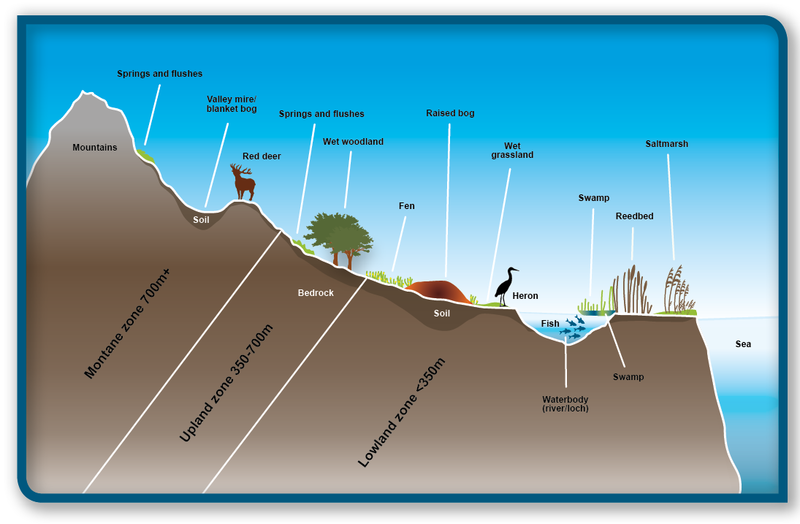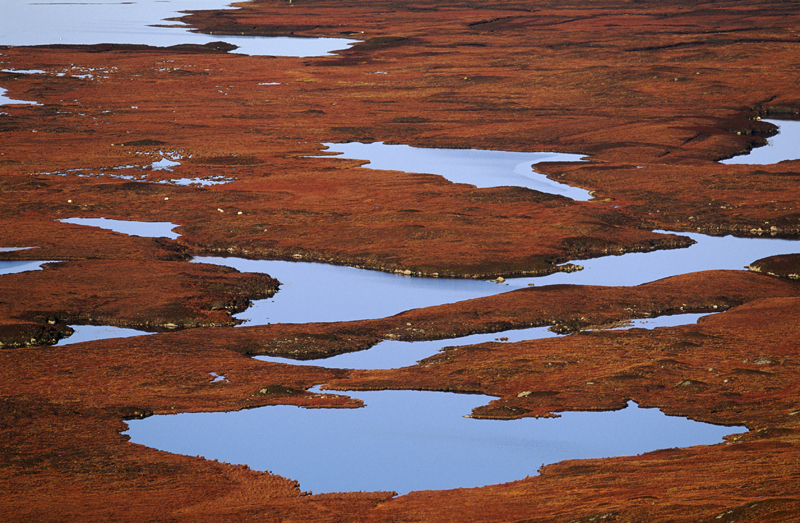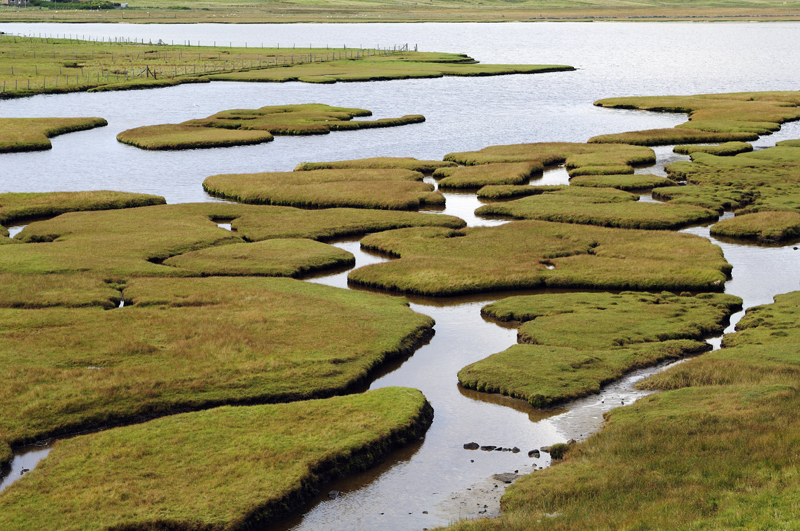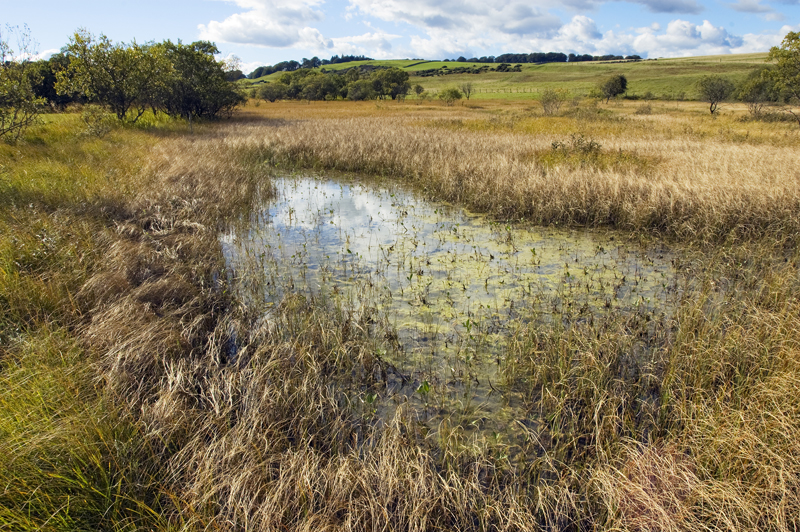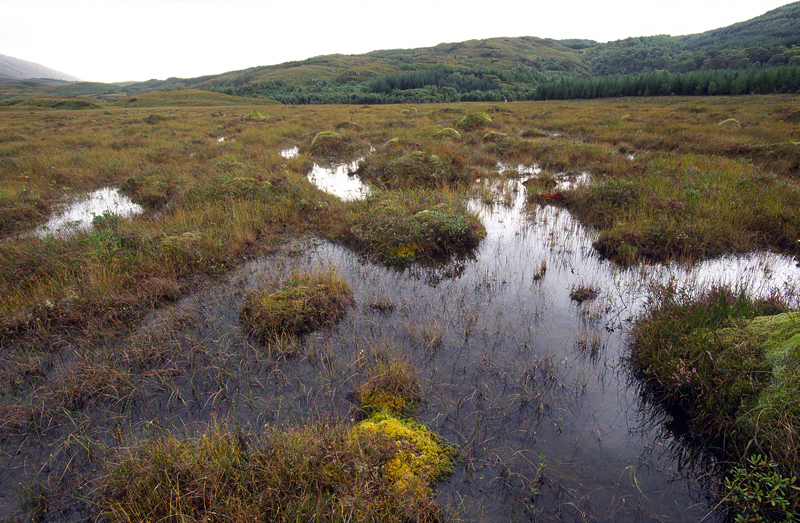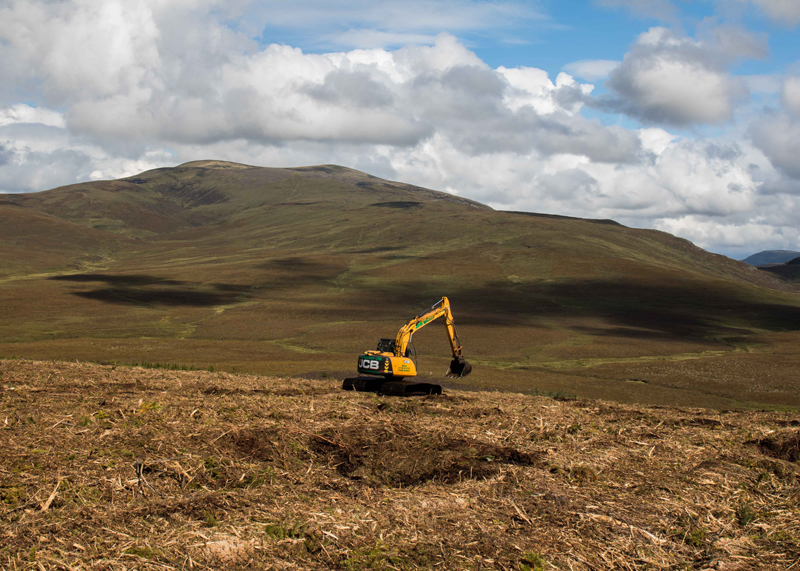Scotland's wetlands are home to a wide range of plants and animals. They also provide important environmental functions, such as storing carbon and sustaining the supply of clean water.
Key messages
Wetlands cover large areas of Scotland where poorly draining soils, high rainfall and low temperatures create permanently or frequently waterlogged areas.
They range from coastal salt marshes and wet dune slacks, to fens, marshes and wet woodlands in river valleys and loch edges, to the springs and flushes, wet heath and blanket bogs on mountain slopes and plateaux. Wetland types are described in the Scottish wetland typology
Typical setting of wetlands in the Scottish landscape
Source: 2014 State of environment report (Wetlands topic)
The type of wetland that develops depends on where it sits in the landscape. Often, several wetland types can exist in the same location (known as a habitat ‘mosaic’).
Peatlands are wetland areas in which peat has accumulated and can support vegetation that is able to form new peat. Bogs (a type of peatland) are one of the most extensive semi-natural habitats in Scotland.
Peatland at Uist - © Lorne Gill - NatureScot
Peat is associated with many wetlands, and stores huge quantities of carbon. It is estimated that around 1,600 million tonnes of carbon are stored in peat soils in Scotland.
Salt marshes provide a nursery habitat for fish, food for birds and natural protection from coastal erosion and tidal flooding. Between some sand dunes, 'wet dune slacks' form in the hollows; these are flooded in different seasons and create a unique, rare habitat that supports plants such as sedge, moss, cross-leaved heath and creeping willow.
Saltmarsh at Northon, Isle of Harris - © Lorne Gill - NatureScot
Swamps, fens, wet grassland and wet woodland provide feeding and breeding habitats for birds and animals. These wetlands also support a wide range of plants, such as the greater tussock sedge, a variety of mosses and early marsh-orchid. They also provide rich grazing for livestock and can store water during floods.
Whitelaw Moss National Nature Reserve - © Lorne Gill - NatureScot
Blanket bog is found where the climate is cool and wet. It can develop on gentle slopes near the top of hills and across large areas of the far North. These extensive areas of rain-fed bog support plants like cotton grass and many species of Sphagnum moss and heather. Blanket bogs are often interspersed with groundwater-fed fens and flushes. They store and accumulate large quantities of carbon in peat. Land-management practices in these upland catchments, in particular artificial drainage, can reduce the bogs’ ability to slow down floods and provide clean drinking water.
Blanket bog at Claish Moss NNR, Ardnamurchan - © Lorne Gill - NatureScot
Functions of wetlands and associated benefits
| Function |
Benefit |
| Carbon storage and accumulation |
Wetlands that create peat can store large quantities of carbon for thousands of years. Some management practices (e.g. drainage) can trigger the release of carbon (methane, carbon dioxide, particulate and dissolved carbon). |
| Water purification |
Wetlands often form between land and open water, and can prevent pollutants (suspended solids, nitrogen and phosphorus) getting into rivers and lochs. Some artificially created wetlands (e.g. in Sustainable Drainage Systems (SuDS)) are constructed primarily to remove pollutants from run-off in towns and cities and retain flood water. |
| Flood management |
Wetlands slow the flow of rain water into rivers and lochs, which can slow down flooding. They can store floodwater in the floodplain, reducing the peak of the floodwater that passes through our towns and cities.
On the shorelines of lochs and on the coast, wetlands act as a natural defence against coastal erosion. |
| Water supply / groundwater infiltration |
Wetlands collect and store water, which replenishes groundwater and therefore the water supply.
Most Scottish drinking water has passed through a wetland before it reaches a reservoir. How these wetlands are managed affects the quality of the drinking water and the costs of purification treatments that may be needed. Artificially created wetlands play an important role in local water management where chemical or mechanical means would otherwise be needed to treat the water; for example, in sewage management.
|
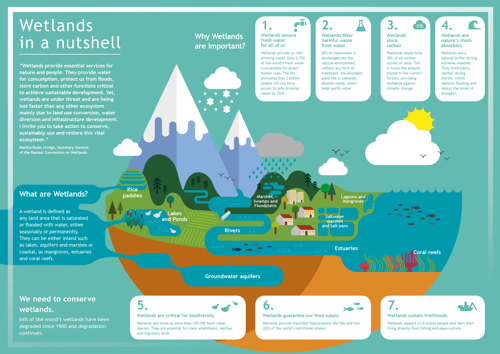
Source: Wetlands in a nutshell - Published by RAMSAR
Data
Protected wetland sites
Find out more about the condition of Scotland’s wetlands in the protected nature sites data analysis application.
Wetland’s of international importance - RAMSAR - data is available to download from NatureScot data services.
Location of Scottish wetlands
View the Scottish wetland inventory data on the Scotland’s environment map. Click on the zoom icon in to view the data.
Locations and extent of wetlands (areas not yet surveyed have been left blank; they may contain wetlands). Please note: the area of Dumfries and Galloway was surveyed using a different methodology to the rest of the country.
Scottish wetland inventory data is available to download from SEPA's environmental data page.
What are we doing?
Development - The Scottish Environmental Protection Agency (SEPA) and NatureScot are statutory consultees in the planning system on developments that could damage wetlands, SEPA issues licenses on activities that might impact on wetlands. In both SEPA and NatureScot, a risk-screening approach is taken when assessing developments and activities close to wetlands, and an assessment of the impact is made as part of the licensing or planning application. In some cases, measures are put in place to protect the wetland habitat and its supporting hydrology.
Flood management - In 2015, the Scottish Environmental Protection Agency published the Natural Flood Management handbook which provides a practical guide to the delivery of natural flood management. The handbook includes role of wetlands in this process. The guidance provided is primarily aimed at local authorities tasked with delivery of actions set out in the Flood Risk Management Strategies.
Land management - The Scottish Government has identified wetlands as a priority within the Scottish rural development programme 2014-2020, providing financial support for land managers to:
- Manage existing wetlands or create new wetlands in a way that helps their plants and wildlife and also their potential to reduce flooding, absorb nutrients and trap silt
- restore our lowland raised bogs and provide a habitat for a wide range of wildlife, as well as giving some limited agricultural use. The raised bogs will once again become an open wet landscape feature
- protect and enhance the condition of uplands and peatlands
Action for peatlands - Scotland's National Peatland Plan was published in 2015 to highlight the major contribution peatlands make to Scotland. The Peatland ACTION project began in 2012, tasked with kick-starting peatland restoration across Scotland. NatureScot also provides advisory support and best practice videos and guidance which includes lessons learnt from initiating and running practical peatland projects across Scotland.
YouTube: NatureScot - Peat Bog Restoration in Scotland
Forest and Land Scotland are active in the restoration of:
Dalchork, North Highland - © Forestry Commission Scotland
The Peatland Code is a voluntary standard for UK peatland projects wishing to market the climate benefit of restoration.
Policy and legislation
Ramsar is the name of a town in Iran where the Convention on Wetlands of International Importance was adopted in 1971. The UK Government signed up to the Convention in 1976. The mission of the Convention is "the conservation and wise use of all wetlands through local and national actions and international cooperation, as a contribution towards achieving sustainable development throughout the world".
All Ramsar sites in Scotland are also either Special Protection Areas (SPAs) or Special Areas of Conservation (SACs), Natura sites, and many are also Sites of Special Scientific Interest (SSSIs).
You can view all Ramsar sites in Scotland on the Scotland’s environment web protected nature sites data analysis tool and Scotland's environment map.
Wetlands in the wider countryside (non-designated sites) are being protected through legislative and regulatory mechanisms established under the European Water Framework Directive, Nature Conservation (Scotland) Act 2004 and Habitats Directives for Natura sites.
The ecosystem services-based evaluation of land use as highlighted by the National Ecosystem Assessment has meant that wetlands are now more widely recognised for the functions they provide.
These images are subject to copyright and are for single use only. Please contact NatureScot
This page was reviewed on 10 Oct 2019
Adobe Acrobat Reader is the free, trusted leader for reliably viewing, annotating and signing PDFs.
Download Adobe Acrobat Reader

